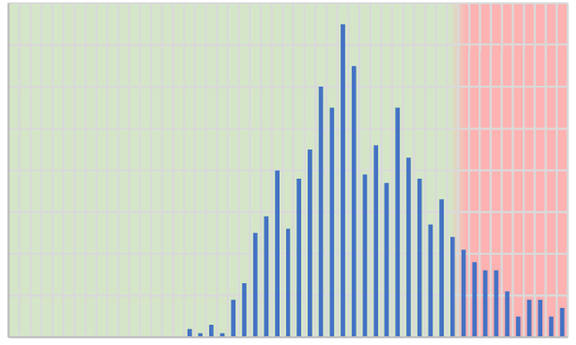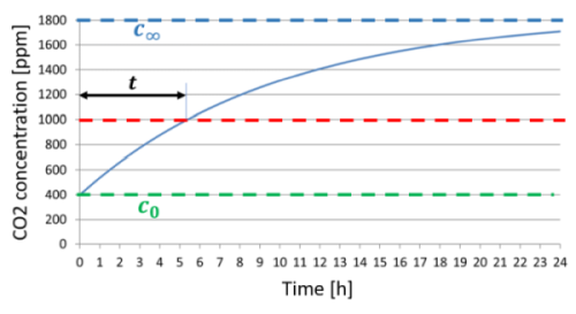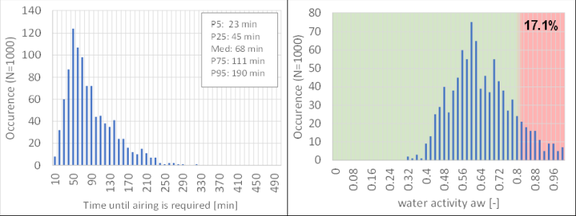Introduction
Increasing energy efficiency and building airtightness requirements have led to an ongoing debate about suitable measures to ensure proper indoor air quality and humidity levels in residential buildings. In Austria “sufficient ventilation” is required by building regulations (OIB, 2019), without further specifying how this should be accomplished or to what extent active intervention by building occupants, for example by window airing, is reasonable to assume. The lack of guidelines or standards has caused many discussions and disputes on the question if “sufficient ventilation” can be ensured with window airing only or if mechanical ventilation should be foreseen, in particular in newly constructed residential buildings. A proper calculation during the design stage requires the use of numerical simulation tools and expert knowledge in building simulation.
To support architects, building administrators, building developers, building owners, and regulating bodies in their decision process on how to ventilate their buildings, we developed a calculation method that can be implemented in an easy-to-use tool. It estimates the risk of mold growth and the time intervals between window airing events required to maintain good indoor air quality. In a first step the calculation method has been implemented in a spreadsheet software and is available for download. In a second step we will implement this calculation in a yet easier to use online-calculation tool.
Physical modeling
The calculation focusses on two very important indoor air quality parameters, namely CO2 concentration and air humidity. High indoor air humidity levels increase the risk of condensation and/or mold growth and are therefore deteriorative to occupant health and building structure. CO2 concentration is often used as an indicator of indoor air quality because it is easy to measure and correlates with occupancy and occupant activity. It is therefore considered a good indicator for occupancy-related ventilation demand.
The calculations are based on simple mass balance equations for CO2 and water vapor concentration (H2O) in the air volume. This way the time interval between window airing events, required to keep CO2 concentration below the guideline value, can be calculated for any given boundary condition. In a similar way the H2O mass balance equation can be used to calculate vapor density which can be used to estimate mold risk on external walls when considering their inner surface temperature. Knowing the wall surface temperature and the indoor air humidity one can calculate the water activity, i.e. the relative humidity of the air in contact with the wall surface. The risk of mold growth is very high when the water activity is above 80%. The inner surface temperature of external walls can be estimated using the fRSI factor. It is a dimensionless quantity for assessing thermal bridges.
Both the estimation of the time interval between airing and the estimation of the mold risk require input regarding the air exchange rate due to in- and exfiltration, i.e. the air that in- and exfiltrates through little gaps and cracks in the building envelope. It depends on the airtightness of the building and is driven by wind and temperature differences between inside and outside (chimney effect), resulting in a high temporal variability. There are several approaches for estimating this air exchange rate. We opted for the LBL model, a simplified physical model, empirically calibrated and validated in numerous studies. Further details can be found in the original publications of this work.
Monte-Carlo simulation
As required by the contracting authority, the calculation method should not require a special software, e.g. building performance simulation tool, and its application should allow for different levels of user knowledge and engagement. But the calculations described above require a large number of input parameters with respect to building type, geometry, tightness, terrain, etc. and information about the building occupants and the resulting source strengths (of CO2 and H2O). Furthermore, the highly variable ambient conditions (temperature, humidity, and wind strength) enter into the calculations. The question arises how to deal with the uncertainty or variability of these input parameters. Most input parameters can be assigned a value range rather than a single value. In a deterministic calculation approach, one would have to select a single representative value for each input parameter. The big disadvantage of this is that the information about the variance of the input parameters and their influence on the variance of the result is lost. Especially for the evaluation of indoor air quality and mold risk, this loss of information is problematic, because issues might occur for non-representative conditions. The methodology should therefore be able to identify and quantify not only the "worst case" but also the "intermediate" and "best case" conditions and their probability of occurrence. For this purpose, all input parameters must be varied within their value range. This quickly leads to an unmanageable number of combinations. The Monte-Carlo (MC) approach offers a remedy. Instead of computing the entire parameter space (every possible combination), this approach computes only a random sample from the entire pool of value combinations. In the method presented here, 1000 parameter combinations are computed for each query. The value of each parameter is randomly chosen according to a stored probability distribution function (PDF). In total 170 PDFs are defined, examples are shown in Figure 2.

Figure 2: Examples of probability density functions based on beta distributions used to define variability of input parameters. Left: Airtightness value for standard new constructions [1/h]. Center: Room area for bedrooms [m2]. Right: window tightness class for old buildings (is consequently rounded to integer value).
Exemplary results & outlook
In an exemplary query the window airing requirement for a bedroom in a newly constructed multi-family building was assessed. Figure 3 (left) shows the histogram of the required window airing interval. In 50% of the cases, the Austrian indoor air quality guideline limit (8h-average CO2 concentration should be below 1000 ppm) would be exceeded after 68 minutes or sooner. This is substantially shorter than an “acceptable” occupant intervention interval of 8 hours for this room type. Our algorithm also estimates a high mold risk for this building, see Figure 3 (right). It shows that in 17% of the cases the water activity of critical wall surfaces, i.e. thermal bridges, would be greater 0.8 for at least 24 hours, a condition enabling mold growth on that surface.
The presented calculation method can be used to asses if natural in-/exfiltration and window airing can provide sufficient ventilation to comply with given CO2 concentration limits and avoid mold growth. It’s “simple-to-use” stochastic approach is based on simplified physical models and has been implemented in a spreadsheet in a first step. We are currently working to implement this calculation method in an online calculation tool.
Acknowledgements
This work was financed by the Austrian Federal Ministry for Climate Action, Environment, Energy, Mobility, Innovation and Technology (BMK).
References
Gabriel Rojas, Andreas Greml, Rainer Pfluger & Peter Tappler (2023): Assessing the “sufficient ventilation” requirement for Austrian buildings: development of a Monte Carlo based spreadsheet calculation to estimate airing intervals and mould risk in window ventilated buildings, International Journal of Ventilation, DOI: 10.1080/14733315.2023.2198788
Andreas Greml, Gabriel Rojas, Rainer Pfluger & Peter Tappler (2021). Lüftungskonzept Österreich. https://nachhaltigwirtschaften.at/de/sdz/projekte/lueftungskonzept-oesterreich.php
DOI: https://www.doi.org/10.48763/000006
This work is licensed under a Creative Commons Attribution 4.0 International License.
Written by Gabriel Rojas-Kopeinig in June 2023.
Assistant Professor at DiSC & Unit of Energy Efficient Building at the Department of Structural Engineering and Material Sciences
University of Innsbruck
About the author
My academic work centers on energy-efficient construction. Specifically, I explore how we can design buildings in such a way that they provide a comfortable and healthy indoor climate while conserving energy and resources. To answer this question, I use both experimental and computational simulation methods, such as building performance and air flow simulations. My research focuses on indoor air quality, thermal comfort, and energy efficiency. In addition, I also seek to improve the aforementioned simulation methods by combining and enhancing them with data-driven methods, for example data-driven modeling or model calibration.
Research area
Digital Methods in Indoor Environment and Building Energy Research





